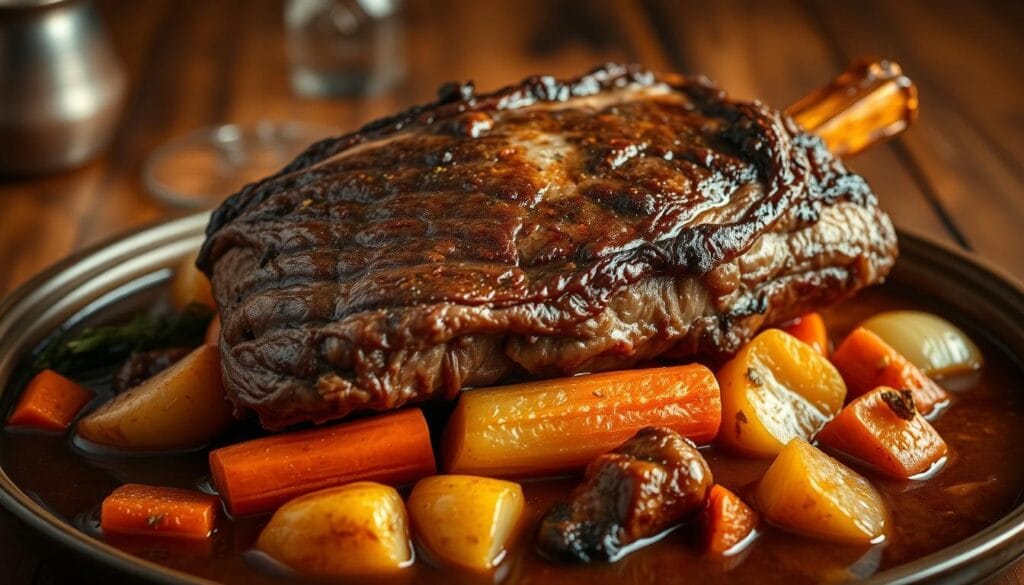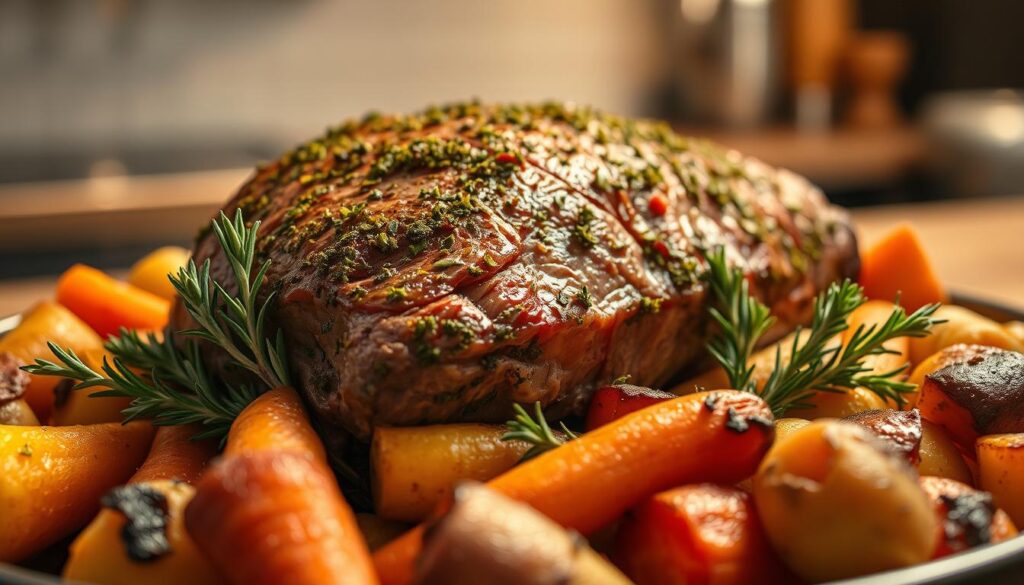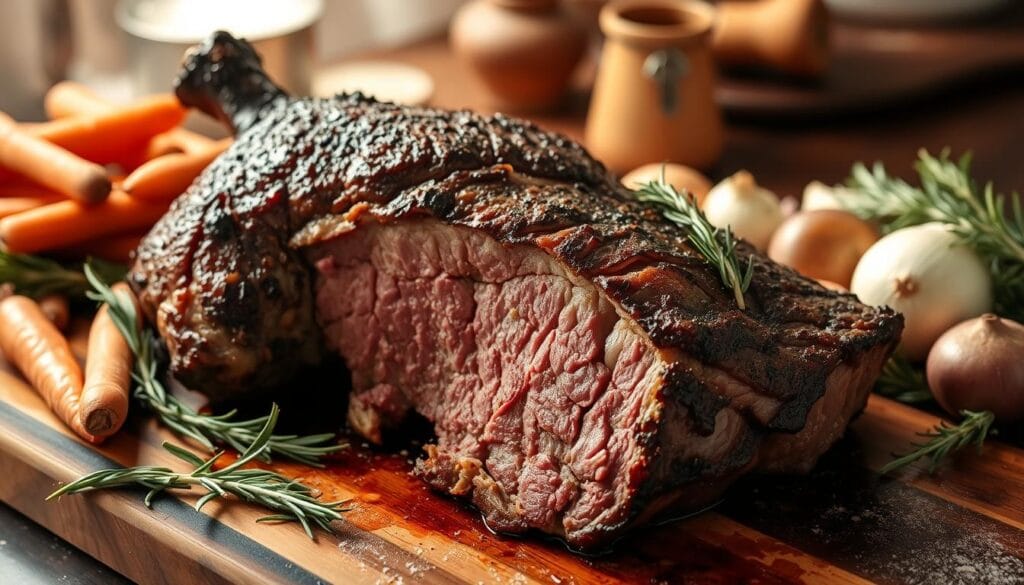Imagine coming home to a tender, flavorsome beef shoulder roast surrounded by roasted vegetables. It’s a meal that satisfies your hunger and warms your heart.
Creating this comforting dish is easy, whether you use your oven or slow cooker. The beauty of a beef shoulder roast recipe is its versatility and simplicity.
Table of Contents
Exploring different recipes, you’ll find that great dishes balance flavors and textures. Whether you’re experienced or new to cooking, a well-cooked beef shoulder roast with vegetables will become a favorite.
Key Takeaways
- Discover the ease of cooking a beef shoulder roast with vegetables using different methods.
- Learn how to achieve tender and flavorful results every time.
- Explore various recipe variations to suit your taste preferences.
- Understand the benefits of using a slow cooker or oven for roasting.
- Get tips on balancing flavors and textures in your roast.
Understanding Beef Shoulder Roast
To cook beef shoulder roast well, you need to know its characteristics. It’s known for its rich flavor and tender texture. This makes it a hit with chefs and home cooks alike.
What Makes Beef Shoulder Roast Special
Beef shoulder roast is special because of its flavor profile and texture. Slow-cooking makes it tender and juicy. This creates a wonderful eating experience.
Flavor Profile and Texture
The flavor of beef shoulder roast is rich and beefy. It’s tender and falls apart when cooked right. This happens because the connective tissues break down during cooking.
Nutritional Benefits
Beef shoulder roast is not just tasty but also nutritious. It’s full of protein, vitamins, and minerals. This makes it a healthy choice for dinner.
Cuts and Varieties of Beef Shoulder
There are many cuts and varieties of beef shoulder roast. Knowing the differences helps you pick the right one for your recipe.
Chuck Roast vs. Shoulder Clod
The chuck roast and shoulder clod are two common cuts. Both can make a tender beef dish. But they differ in fat content and bone presence.
Bone-in vs. Boneless Options
Choosing between bone-in or boneless beef shoulder roast matters. Bone-in roasts are more flavorful. Boneless ones are easier to carve.
Understanding these points helps you pick the right beef shoulder roast. This ensures a juicy beef roast every time.
Selecting and Preparing Your Beef Shoulder Roast
A tender and flavorful beef shoulder roast starts with the right selection and preparation. To get the best beef roast recipe, knowing what makes a good roast is key. Also, learning how to prepare it is crucial.
How to Choose Quality Beef Shoulder
When picking a beef shoulder roast, consider a few things. The quality of the roast greatly affects your easy beef roast recipe.
Marbling and Color Indicators
Look for a roast with good marbling. This makes the roast tender and flavorful. Also, a deep red color means it’s fresh.
Organic and Grass-Fed Options
Opt for organic or grass-fed beef for a richer flavor. These choices can make your roast taste better.
Essential Preparation Steps
After picking your beef shoulder roast, it’s time to get it ready for cooking. Proper preparation is vital for a great roast.
Trimming and Tying Techniques
Remove any extra fat to avoid a greasy roast. Tying the roast with twine ensures it cooks evenly.
Bringing to Room Temperature
Let the roast reach room temperature before cooking. This helps it cook evenly and consistently.
Seasoning Techniques for Maximum Flavor
Seasoning is where you can really make your best beef roast recipe stand out. There are many ways to boost your roast’s flavor.
Dry Rubs and Marinades
Using a dry rub or marinade adds depth to your roast. Garlic, thyme, and rosemary are great choices.
Aromatics and Herbs
Adding aromatics like onions and carrots, along with herbs, enhances the flavor. These elements pair well with the beef.
The Best Beef Shoulder Roast Recipe with Root Vegetables
Discover the ultimate comfort food with our oven-roasted beef shoulder recipe. It’s perfectly paired with a medley of root vegetables. This dish is perfect for a cold winter’s night or a special occasion. It offers a rich, satisfying meal that’s sure to impress.
Ingredients You’ll Need
To create this delicious oven-roasted beef shoulder, you’ll need the following ingredients:
Meat Selection and Preparation
Choose a 3-4 pound beef shoulder roast. Season it with salt, pepper, and your choice of herbs (such as thyme and rosemary).
Vegetable Combinations
Select a variety of root vegetables like carrots, potatoes, and parsnips. You can also add onions and garlic for extra flavor.
- 3-4 carrots, peeled and chopped
- 2-3 medium-sized potatoes, peeled and chopped
- 2 parsnips, peeled and chopped
- 1 large onion, chopped
- 3 cloves of garlic, minced
Step-by-Step Cooking Instructions
Follow these steps to achieve a perfectly cooked beef shoulder roast:
Searing the Meat Properly
Preheat your oven to 325°F (165°C). Sear the beef shoulder roast in a hot skillet on all sides until it’s nicely browned.
Adding Vegetables at the Right Time
Add the chopped root vegetables around the roast in the skillet. You can also add them to a roasting pan if you prefer.
Creating the Perfect Gravy
After roasting, remove the roast and vegetables from the pan. Use the pan drippings to make a rich gravy. Deglaze with a bit of red wine or beef broth, then whisk in some flour to thicken.
| Cooking Step | Time | Temperature |
|---|---|---|
| Searing | 5 minutes per side | High heat |
| Roasting | 2-3 hours | 325°F (165°C) |
| Gravy preparation | 10-15 minutes | Medium heat |
Tips for Perfect Results
To ensure your beef shoulder roast turns out perfectly, follow these tips:
Temperature Monitoring
Use a meat thermometer to check the internal temperature of the roast. It should reach 160°F (71°C) for medium-rare.
Resting the Meat
Once cooked, let the roast rest for 15-20 minutes before slicing. This allows the juices to redistribute, making the roast even more tender.
By following this recipe and these tips, you’ll be able to create a delicious, comforting oven-roasted beef shoulder with root vegetables. It’s sure to become a staple in your household.
Slow Cooker Beef Shoulder Roast with Seasonal Vegetables
Slow cooker beef shoulder roast recipes are easy and tasty. They’re great for making tough cuts tender. This makes for a satisfying dinner.
Why Slow Cooking Works Best for Shoulder Cuts
Slow cooking is perfect for beef shoulder roast. It cooks the meat low and slow. This breaks down tough fibers and adds rich flavors.
Breaking Down Tough Fibers
The slow cooking breaks down collagen in the meat. This turns it into gelatin, making the roast tender and juicy.
Flavor Development Over Time
As the roast cooks, flavors from seasonings and vegetables soak into the meat. This makes the dish rich and savory.
Easy Slow Cooker Recipe
To make a tasty slow cooker beef shoulder roast, follow these steps:
Layering Ingredients Properly
Begin by layering sliced onions and your favorite vegetables at the bottom of the slow cooker. Then, place the seasoned beef shoulder roast on top.
Timing and Temperature Settings
Cook the roast on low for 8-10 hours or on high for 4-6 hours. It should be tender and fall apart easily.
Finishing Touches
About 30 minutes before serving, add more vegetables like carrots or potatoes. This keeps them tender but with some crunch.
| Vegetable | Season | Cooking Time |
|---|---|---|
| Carrots | All Year | 30 minutes |
| Potatoes | All Year | 45 minutes |
| Green Beans | Spring/Summer | 20 minutes |
Vegetable Combinations That Complement Beef Shoulder
You can change up the vegetables with the seasons. This keeps your slow cooker beef shoulder roast fresh and flavorful.
Spring and Summer Options
In spring and summer, add asparagus, green beans, or bell peppers to your slow cooker.
Fall and Winter Choices
In fall and winter, try carrots, parsnips, and turnips. They add nice texture and flavor to the dish.
Oven-Roasted Beef Shoulder with Mediterranean Vegetables
Experience the warmth of Mediterranean cuisine with a hearty oven-roasted beef shoulder, accompanied by vibrant vegetables. This dish combines the rich flavors of the Mediterranean with the tender, fall-apart texture of slow-cooked beef shoulder.
Mediterranean Flavor Profile
The Mediterranean flavor profile is characterized by fresh herbs, citrus, and olive oil. These elements create a dish that is both aromatic and flavorful.
Herb and Spice Combinations
Herbs like rosemary, thyme, and oregano are staples in Mediterranean cuisine. When combined with spices such as garlic and paprika, they add depth and warmth to the beef shoulder.
Olive Oil and Citrus Elements
Olive oil is used liberally in Mediterranean cooking, for flavor and health benefits. A squeeze of fresh citrus, like lemon or orange, adds brightness to the dish.
Cooking Method and Timing
Cooking the beef shoulder in the oven allows for even heat distribution. This ensures the meat is tender and the vegetables are roasted to perfection.
Temperature Stages for Perfect Results
Start by searing the beef shoulder at a high temperature to lock in the juices. Then, reduce the heat to finish cooking it slowly.
Vegetable Addition Timeline
Add root vegetables like carrots and potatoes early in the cooking process. More delicate vegetables like bell peppers and zucchini can be added later.
Serving Suggestions
Serve the oven-roasted beef shoulder with a variety of sides that complement its Mediterranean flavors.
Accompaniments and Sides
Consider serving with a side of warm pita bread, a simple green salad, or roasted vegetables.
Presentation Ideas
Garnish with fresh herbs and a drizzle of olive oil. This enhances the visual appeal and ties in with the Mediterranean theme.
Tender Beef Shoulder Pot Roast with Hearty Vegetables

To make a tender beef shoulder pot roast, you need to understand the importance of braising. Braising is a cooking technique that cooks the beef in liquid over low heat for a long time. This results in tender and flavorful meat.
The Secret to Ultra-Tender Beef Shoulder
The key to achieving ultra-tender beef shoulder is to use the right braising techniques and liquid selection. Braising techniques involve cooking the beef in a covered vessel, which helps to retain moisture and promote tenderization.
Braising Techniques
Braising involves searing the beef shoulder first to create a flavorful crust, then cooking it in liquid on low heat. This technique breaks down the connective tissues, making the beef tender and juicy.
Liquid Selection for Flavor
The choice of liquid is crucial for adding flavor to the beef. You can use stock, wine, or a combination of both to create a rich and savory sauce. Red wine, in particular, adds a depth of flavor that complements the beef beautifully.
One-Pot Recipe Instructions
Cooking the beef shoulder pot roast in one pot is convenient and minimizes cleanup. You can use either a Dutch oven or a covered roasting pan for this purpose.
Dutch Oven vs. Covered Roasting Pan
Both Dutch ovens and covered roasting pans are suitable for braising beef shoulder. A Dutch oven is ideal for stovetop-to-oven cooking, while a covered roasting pan is better suited for oven cooking.
Step-by-Step Process
- Sear the beef shoulder in a hot pan to create a crust.
- Add aromatics like onions and garlic to the pan.
- Add liquid to cover the beef and bring to a boil.
- Cover the pan and transfer it to the oven to cook until tender.
Make-Ahead and Storage Tips
This recipe can be made ahead and refrigerated or frozen for later use. Proper storage is essential to maintain the quality of the dish.
Refrigeration Guidelines
Refrigerate the cooked pot roast within two hours of cooking and consume within three days.
Freezing and Reheating Methods
Freeze the cooled pot roast and reheat it gently in the oven or on the stovetop when needed.
| Storage Method | Duration | Reheating Method |
|---|---|---|
| Refrigeration | Up to 3 days | Oven or Stovetop |
| Freezing | Up to 3 months | Oven or Stovetop |
Asian-Inspired Beef Shoulder Roast with Stir-Fried Vegetables
Take your roast to the next level with an Asian-inspired beef shoulder roast. It’s tender and full of flavor. This recipe combines Asian tastes with traditional roast beef, making it a hit.
Fusion Flavor Combinations
The marinade is key to this dish. Soy sauce, ginger, and garlic mix together for a rich, savory taste. It’s all about the Asian flavors.
Soy, Ginger, and Garlic Marinade
For the marinade, combine 1/4 cup of soy sauce, 2 tablespoons of grated ginger, and 3 cloves of minced garlic. This blend will give your beef a deep, umami flavor.
Complementary Spices and Sauces
Add depth with spices like five-spice powder and hoisin sauce. They enhance the roast’s flavors.
Two-Part Cooking Process
A tender roast needs a two-step cooking method. First, slow-roast the beef. Then, quickly stir-fry your favorite vegetables.
Slow-Roasting the Beef
Heat your oven to 300°F (150°C). Season the beef with salt and pepper. Roast for about 3 hours until it’s tender.
Quick-Cooking the Vegetables
While the beef roasts, prep your veggies. Stir-fry 1 cup of broccoli, 1 cup of bell peppers, and 1 cup of carrots in a bit of oil until they’re tender-crisp.
| Vegetable | Cooking Time |
|---|---|
| Broccoli | 3-4 minutes |
| Bell Peppers | 4-5 minutes |
| Carrots | 5-6 minutes |
Presentation Ideas
Slice the roast against the grain. Serve with stir-fried veggies. Top with sesame seeds and green onions for color and extra taste.
Herb-Crusted Beef Shoulder Roast with Roasted Vegetables

Make your dinner special with a flavorful herb-crusted beef shoulder roast and roasted veggies. This dish is a mix of tender beef and tasty herbs. It’s perfect for any meal.
Creating the Perfect Herb Crust
The secret to a great herb crust is mixing fresh and dried herbs. Fresh herbs like parsley and thyme add a bright taste. Dried herbs like oregano and rosemary bring depth.
Fresh vs. Dried Herb Combinations
Using both fresh and dried herbs makes the flavor richer. For example, parsley and oregano together taste amazing.
Binding Techniques
To keep the herb crust on the beef, mix olive oil, mustard, and breadcrumbs. This helps the herbs stick and adds texture.
Vegetable Roasting Guide
Roasting veggies with your beef adds variety. Carrots, potatoes, and Brussels sprouts are great choices.
Timing for Different Vegetable Types
Each veggie roasts at a different time. Carrots take longer than Brussels sprouts.
Seasoning and Oil Recommendations
Before roasting, toss veggies in olive oil, salt, and pepper. You can also add garlic powder or paprika for more taste.
Wine Pairing Recommendations
Choosing the right wine can make your meal better. For herb-crusted beef, try a red wine like Cabernet Sauvignon or Merlot.
Red Wine Options
Red wines pair well with beef roasts. Look for wines with good acidity to balance the richness.
Alternative Beverage Pairings
Troubleshooting Common Issues with Beef Shoulder Roast Recipes
Getting a tender and juicy beef shoulder roast is easy with some tips. Even skilled cooks can face problems like toughness or dryness. Knowing the reasons and fixes can greatly help.
Fixing Tough or Dry Roasts
Identifying the Root Cause
Tough or dry roasts usually come from overcooking or not tenderizing enough. Make sure your cooking time and temperature match your recipe.
Rescue Techniques and Solutions
If your roast is tough, try cutting it thinly against the grain. This can make it more tender. For dry roasts, a rich sauce or gravy can add moisture and flavor.
Adjusting Cooking Times and Temperatures
Altitude and Oven Variations
Cooking at high altitudes or in different ovens can change your roast’s result. Adjust cooking times and temperatures to match these changes.
Size and Weight Considerations
The size and weight of your beef shoulder roast affect cooking time. Bigger roasts need lower temperatures and longer cooking to be tender.
Conclusion: Mastering the Art of Beef Shoulder Roast
Learning to make beef shoulder roast is a journey filled with flavors and techniques. You’ve seen many beef shoulder roast recipe ways, like slow cooker and oven-roasting. Each way makes the beef tender and tasty.
Trying different seasonings, veggies, and cooking styles lets you make a slow cooker beef roast or oven dish just how you like it. The secret is knowing the beef shoulder’s traits and using the right cooking ways.
As you keep trying new beef shoulder roast recipes, you’ll get better. Don’t hesitate to add new ingredients, flavors, and cooking methods to your recipes. Soon, you’ll be a pro at making beef shoulder roast, wowing everyone with your cooking.

